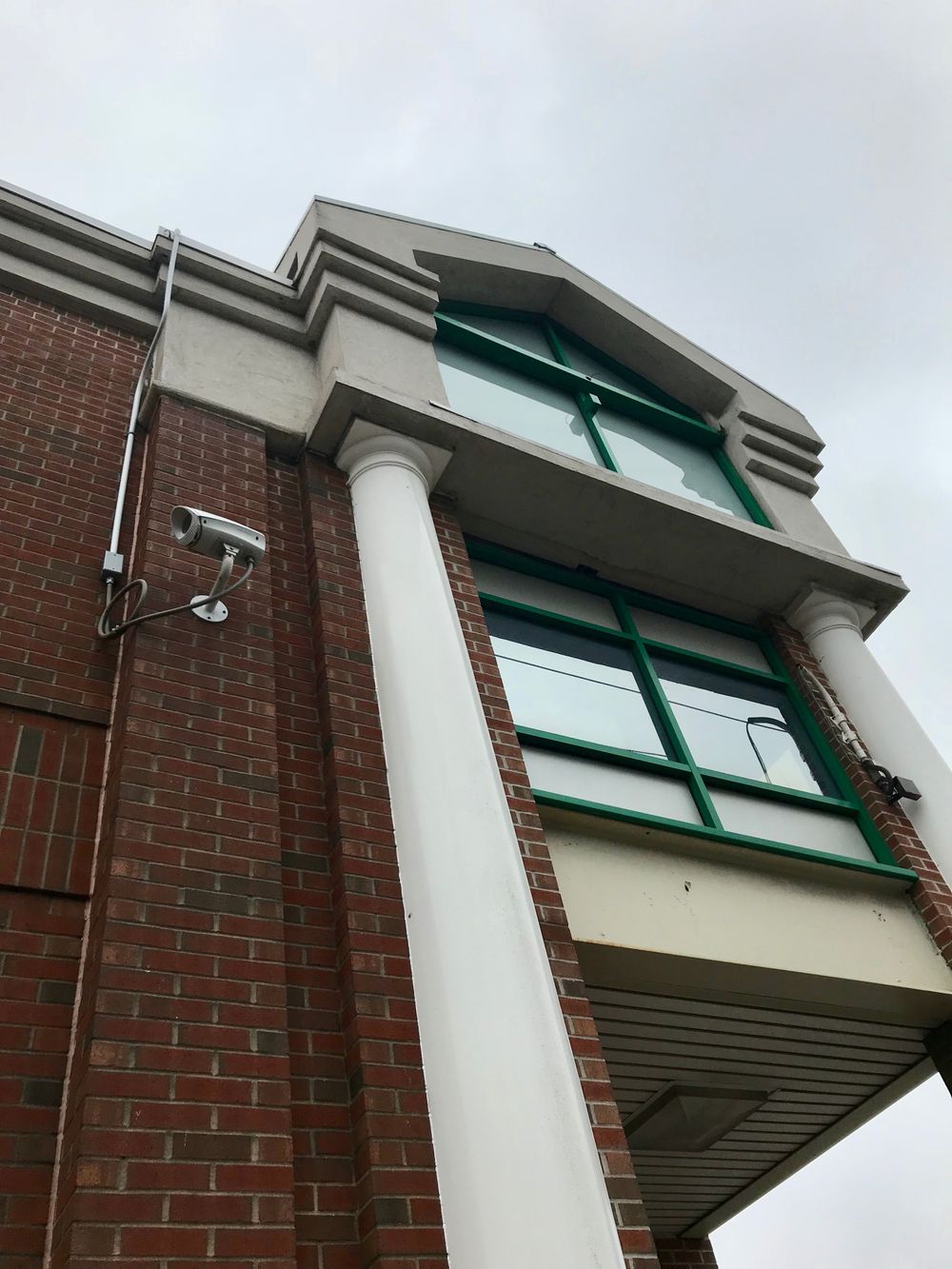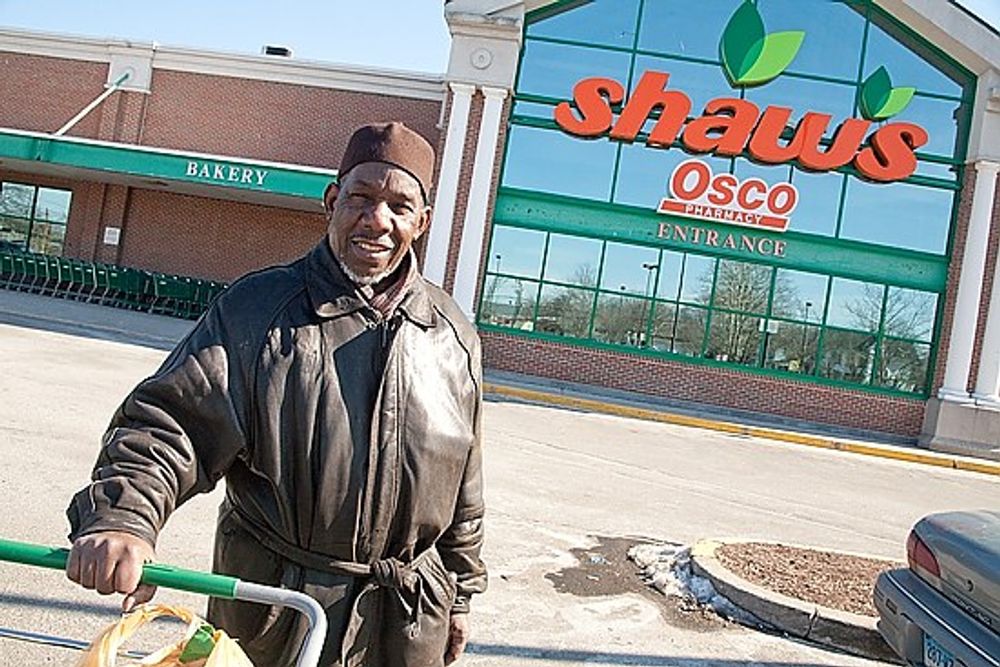
Stop & Shop
150 Whalley Ave
A behemoth of a building, constructed at the close of the 20th century to serve as a supermarket for the inner city. The massive brick-and-concrete structure offers a few ornamental details, including a handful of neoclassical columns and a Tudoresque glass front, but generally its effect is more functional than beautifying. It exists to avert a food desert; looking pretty is beside the point. Positioned on the remains of Whalley’s former “automobile row,” Stop & Shop now provides fresh and accessible food to Dwight neighborhood residents and Yale students alike.
Whalley Avenue, a radial highway branching off New Haven’s central grid, was established around 1797 (12). By the late 1800s, the land around its intersection with Orchard had developed into a residential neighborhood replete with Italianate and Neoclassical houses. A neighboring livery and carriage shop tended to transportation, otherwise allowing private homes to dominate the space (13).
But horses and carriages weren’t long for the modern world. By 1913, while the livery and accompanying veterinarians remained, the first automobile agency had appeared (14), and within the next ten years, the livery vanished, replaced by auto shops and repair companies, as well as several filling stations for the cars. Some houses were further uprooted to make way for giant concrete garages that each held up to 80 vehicles (15). As the automobile revolutionized American transportation, accelerating movement and shrinking distances, Whalley Avenue changed to meet the revolution’s demands. Not even the Great Depression could stem the shifting tide: in 1939, there were more car shops than ever (16). Through the mid-20th century, Whalley Avenue came to host a panoply of dealers, supplying Fords and Buicks and Chevrolets, Dodges and Lincolns and Cadillacs, tire shops and repair services, multiple exchanges for used cars (17) (18). The area came to be known as “automobile row" (19), and the old rows of houses, set quaintly upon the street, were demolished to clear the way for it (20).
By the late 1970s, however, Whalley’s auto row was withering. Amidst rising crime, Ford, Pontiac, and Chevrolet “fle[d] to suburbia in droves.” Their lots were filled by fast food emporiums and nightclubs or else left vacant for years (21). In the early 1980s, the community strove to restore the district with help from city funding (22) (23), but by the 1990s, they shifted to seeking a grocer to fill the vacancies. In 1996, Yale University and the Dwight Community Management Team won a $2.4 million federal grant to fund economic development in university towns, later supplemented by an additional $6 million from Yale, and part of the money was funneled into the development of a major supermarket (24). In 1998, Coral New Haven Associates II, LLC, an organization associated with the Greater Dwight Development Corporation, purchased the land, and Shaw’s began building upon it (25). Today, several auto parts stores linger in the area, but Whalley’s automobile row is no more.
The building at 150 Whalley was constructed in July 1998 to house Shaw’s Supermarket, a grocery chain operated by Albertsons and later SuperValu. The opening of Shaw’s followed the combined efforts of grassroots organizations, Yale University, the Hospital of St. Raphael, the Local Initiatives Support Corporation, the Greater Dwight Development Corporation, and a host of other private and public investors to bring a full-scale supermarket to the inner city. While in operation, Shaw’s supplied the surrounding area with fresh and accessible food and hired more than a hundred New Haven residents (4).
In February 2010, SuperValu announced that it would close its Connecticut grocery stores. The majority of its locations were sold to other chains, but no buyer emerged for the Shaw’s on Whalley Avenue (5). The store became a ghost town, and in late March closed down entirely (6). Neighborhood leaders immediately launched into action, campaigning to attract new buyers, fighting to stave off the impending food desert (7). In February 2011, following efforts by professional developers, lawyers, investors, Yale students, and community organizations, Stop & Shop closed a deal to fill the vacancy (8). On April 15, the new store opened its doors to fanfare, giving jobs to 150 New Haven residents (9) and providing fresh produce to customers who’d struggled to access it in the last year (10).
Despite the triumph of this Stop & Shop’s very existence, the store is troubled by allegations of poor management. Yelp users complain of long lines, old meat, and shortages of shopping carts and plastic bags (11). While some of the complaints amount to little more than unvarnished elitism (“Take a look at the people who go here and you'll know why [the service is so bad]”), understaffing and understocking are genuine problems — especially since the Stop & Shop is supposed to serve its neighborhood by hiring residents and providing access to a full range of fresh foods.
Stop & Shop is nestled between Whalley and Elm, just east of Orchard, between many other retail spaces housed in boxy concrete buildings. It anchors Dwight Place, a shopping center sponsored by the Greater Dwight Development Corporation. For many Dwight neighborhood residents and Yale students, it’s the only supermarket accessible by foot — especially important, since many of its customers don’t own cars. As such, it’s a vital source of reasonably priced food; without Stop & Shop, many people would have to drive, bike, or take the bus to shop for produce. Given that the Dwight neighborhood is more densely populated than downtown New Haven, the supermarket serves a critical need.
The streetscape, however, is not ideal. Nearly two decades after the building’s construction, Whalley Avenue — a street with four lanes and plenty of traffic — still lacks a crosswalk anywhere near the store, and the towering façade, set barely a yard back from the sidewalk, squeezes pedestrians toward the racing cars. Again, the design is decidedly unfriendly (2). Maybe such a critical resource doesn’t need to be friendly to be useful, but when the Greater Dwight Development Corporation claims that it provides “a shopping experience for New Haven usually found in the upscale suburbs" (3), one expects the street design to do better.
Like many superstores, Stop & Shop strikes the viewer with a sense of sheer mass. Its single enormous story dominates the space, stretching broadly across the ground, towering over pedestrians and threatening to swallow them. For a building meant to feed people, it’s not very friendly — but its very unfriendliness suggests the cornucopia stocked within.
Beyond the heavy massing, every architectural choice appears to have been made in the interest of warmth. Red brick textures the endless walls; porticoes shelter the carts and customers; at the center of the building’s front, where people enter through sliding doors, projects a structure shaped like the face of a Greek temple. Framed by spare columns and the suggestion of a pediment, it ornaments modern utility with Classical character — though the warm brick swings the overall impression more toward Colonial Revival. The rest of the face is patterned with rectangular glass panels set in a dense green lattice, faintly evoking Tudor half-timbering while reflecting the sky and the parking lot, relieving some of the structure’s weight. The sides of the building are interspersed with similar ornaments: green beams and glass panels, some painted opaque; open pediments and Tuscan columns, some sealed to the walls like buttresses.
Visible security cameras are mounted to the exterior. A sign on one stanchion tells shoppers that their carts will lock if taken beyond the parking lot perimeter, preventing theft. Occasionally, a few lines of graffiti scrawl across the low metal fence separating the building from the sidewalk.
In 2012, the City of New Haven approved the installation of a Stop & Shop-affiliated gas station at the edge of the parking lot, providing an extra utility within easy reach of shoppers (1).
(1) New Haven City Plan Commission, Zoning Ordinance Amendment, Planned Development District #90, 150 Whalley Avenue (New Haven, CT: 2012), https://www.newhavenct.gov/civicax/filebank/blobdload.aspx?BlobID=29759.
(2) Mark Abraham, "Shaw's Plaza Downtown: Street Design Worse than a No-Man's Land Target?" Design New Haven, June 17, 2009, http://downtownnewhaven.blogspot.com/2009/06/shaws-plaza-downtown-street-design.html.
(3) "Accomplishments," Greater Dwight Development Corporation, http://gddcnh.org/accomplishments/.
(4) Melinda Tuhus, "The View From/New Haven; Suburbia in the City, Supermarket-Style," New York Times, September 13, 1998, http://www.nytimes.com/1998/09/13/nyregion/the-view-from-new-haven-suburbia-in-the-city-supermarket-style.html.
(5) Thomas Macmillan, "Whalley Shaw’s May Close," New Haven Independent, February 15, 2010, http://www.newhavenindependent.org/index.php/archives/entry/end_is_near_for_shaws_supermarket/.
(6) Thomas Macmillan, "’Ghost Town’ Shaw’s: The Final Days," New Haven Independent, March 23, 2010, http://www.newhavenindependent.org/index.php/archives/entry/the_last_days_of_shaws/.
(7) Zak Stone, “Dwight Vows to Find Shaw’s Successor," New Haven Independent, March 10, 2010, http://www.newhavenindependent.org/index.php/archives/entry/shaws2/.
(8) Melissa Bailey, “Stop & Shop Hires 150 Workers—All From City," New Haven Independent, March 31, 2011, http://www.newhavenindependent.org/index.php/archives/entry/stop_n_shop/.
(9) Thomas Macmillan, "Dwight Delivered From Food Desert," New Haven Independent, April 15, 2010, http://www.newhavenindependent.org/index.php/archives/entry/the_drought_is_over/.
(10) Thomas Macmillan, "’Ghost Town’ Shaws: The Final Days," New Haven Independent, March 23, 2010, http://www.newhavenindependent.org/index.php/archives/entry/the_last_days_of_shaws/.
(11) “Super Stop & Shop," Yelp, https://www.yelp.com/biz/super-stop-and-shop-new-haven-2.
(12) Doris B. Townshend, The Streets of New Haven: The Origin of Their Names, 2nd ed. (New Haven, CT: New Haven Colony Historical Society, 1998), 152.
(13) Sanborn Maps Publishing Co., Insurance Maps of New Haven, Connecticut, vol. 2 (1886), 52.
(14) Price & Lee Co., New Haven Directory, vol. 74 (1913).
(15) Sanborn Map Company of New York, Insurance Maps of New Haven, Connecticut, vol. 2 (1924), 227.
(16) Price & Lee Co., New Haven (West Haven, East Haven, North Haven, Hamden) Directory, vol. 100 (1939).
(17) Price & Lee Co., New Haven (West Haven, East Haven, North Haven, Hamden, Woodbridge) Directory, vol. 115 (1955).
(18) Price & Lee Co., New Haven (West Haven, East Haven, Woodbridge) Directory, vol. 121 (1961).
(19) Janet Kipphut, “Auto row becomes ‘quality hodgepodge’,” New Haven Register, September 5, 1982.
(20) Sanborn Map Company, Insurance Maps of New Haven, Connecticut, vol. 2 (1973), 227.
(21) Kipphut, “Auto row becomes ‘quality hodgepodge’.”
(22) Arthur M. Horwitz, “Hopes mount as Whalley Avenue changes,” New Haven Register, May 4, 1980.
(23) Kipphut, “Auto row becomes ‘quality hodgepodge’.”
(24) Egidio Dibenedetto, “New Haven starved for a grocer," Yale Daily News, March 2, 2010, https://yaledailynews.com/blog/2010/03/02/new-haven-starved-for-a-grocer/.
(25) "150 Whalley Av.," Vision Government Solutions (2016), http://gis.vgsi.com/newhavenct/Parcel.aspx?pid=18347.
Researcher
Emily Pan
Date Researched
Entry Created
N/A Date
Last Updated
February 26, 2018 at 6:12 PM EST by null
Historic Name
Style
OtherColonial RevivalCurrent Use
CommercialGroceryRetailEra
1980-TodayNeighborhood
OtherTours
Year Built
1998
Architect
Gregory Ninow
Current Tenant
Stop & Shop
Roof Types
FlatStructural Conditions
Very Good
Street Visibilities
Yes
Threats
None knownExternal Conditions
Very Good
Dimensions
56,552 sq. ft.
Street Visibilities
Yes
Owner
Coral New Haven Associates II, LLC
Ownernishp Type
Client
Coral New Haven Associates II, LLC
Historic Uses
RetailCommercial





Comments
You are not logged in! Please log in to comment.